B2B Content Strategy
10 mins read
Demand-Generating Owned Media Funnel Framework for B2B Marketers
An owned media funnel framework for B2B Marketers to strategize and execute owned media efforts more likely to generate demand.


Victor Eduoh
Lead Strategist @ VEC
A double awakening is happening.
On the one hand, SaaS companies are seeing the need to dump their old lead-gen playbooks for a more effective demand-gen approach. At the same time, B2B Marketing Executives charged with making this crucial demand generation transition are realizing that regular content marketing doesn’t work.
The trend says it all.
Before 2018, a B2B SaaS acquiring a media company was rare. That changed after Outreach bought Sales Hacker in 2018. Five years later, several tech giants are following suit:

Make no mistake.
These demand gen-media company awakenings aren’t reserved for tech giants with deep pockets. Startups not buying media firms are becoming one and using it to build loyal audiences, generate, and capture demand.
Take Refine Labs.
They have three podcasts, host weekly live shows, and publish videos of in-person conferences their CEO, Chris Walker, keynotes:
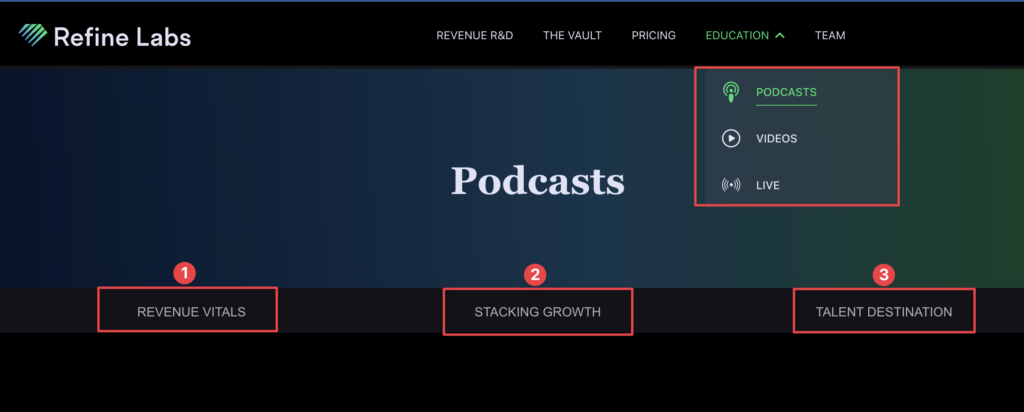
These media efforts haven’t only positioned Refine Labs as a top demand gen agency. But it emboldened them to successfully launch a SaaS product, The Vault, selling directly to the audience it built.
Another handsome example is Mutiny.
They don’t have a podcast (at the time of creating this guide).
But their media-like efforts through an extensive content library of conversion playbooks, case studies, virtual conferences, newsletter, exclusive community, M2, etc., are all doing the demand gen trick:

Again, make no mistake.
As both cases show, it matters less if you buy a media company or become one. What’s paramount is that your media game creates demand, enables capturing that demand, and impacts pipeline.
And to achieve all that…
You Need a B2B Media Funnel
B2B marketing remains a game of funnels.
Going the demand gen route by becoming a media company doesn’t change that. If Outreach’s purchase of Sales Hacker didn’t contribute anything to bottom-line metrics, I doubt other B2B SaaS would tread this path.
You probably won’t be reading this piece, either.
So, like old inbound marketing plays, you still need to funnel people into becoming sales opps. Long-term, that’s how to justify media budgets and ongoing buy-in from the CEO or CFO.
But unlike outdated inbound content playbooks focused on ebook downloads as the measure of sales intent, the media-demand gen route is about building loyal audiences.
Patrick Campbell said it best:
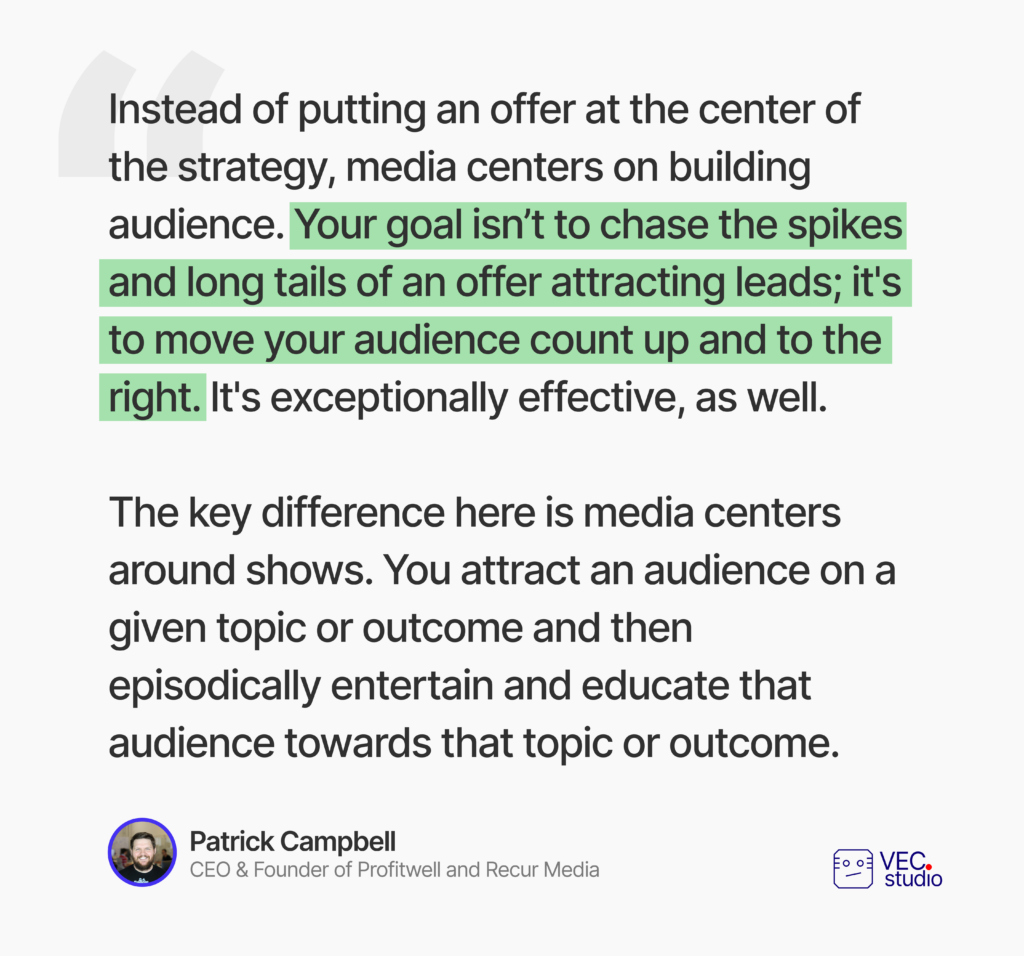
It makes sense.
Prioritizing audience-building over ebook downloads as the measure of sales intent aligns with how we buy software today. Per Gartner research, tech buyers spend only 17% of their entire purchase time talking to reps.
The rest, 83%?
A huge opportunity to strategize and execute a funnel-like media content plan, build audiences, earn prospects’ mindshare while they’re still researching, and generate demand:

And the 17% of time buyers spend talking to reps?
As shown above, you should spend this 17% of your marketing team’s time measuring how you capture the demand being generated. Doing this helps you know what content programs impact pipeline metrics and where to invest more media resources.
Looks easy enough, except for one problem:
How do you map business strategy to prospects’ buying journeys, media-like demand gen content production, distribution, and align all efforts to a funnel to measure how you capture demand?
Enter a framework for that.
The B2B Owned Media Funnel Framework
I examined how our story-driven, product-led SaaS content studio generates demand. When I compared it to how a dozen media-focused tech companies generate demand, these patterns emerged:
- A differentiating Strategic Narrative,
- A content marketing strategy enabling media-like content production to edutain the target market while subtly projecting the narrative,
- Smart distribution focused more on getting content consumed,
- Owned audience management and nurturing, and
- Demand capture measurement to know what’s working.
From my research and these five identified patterns, I designed the Owned Media Funnel Framework:
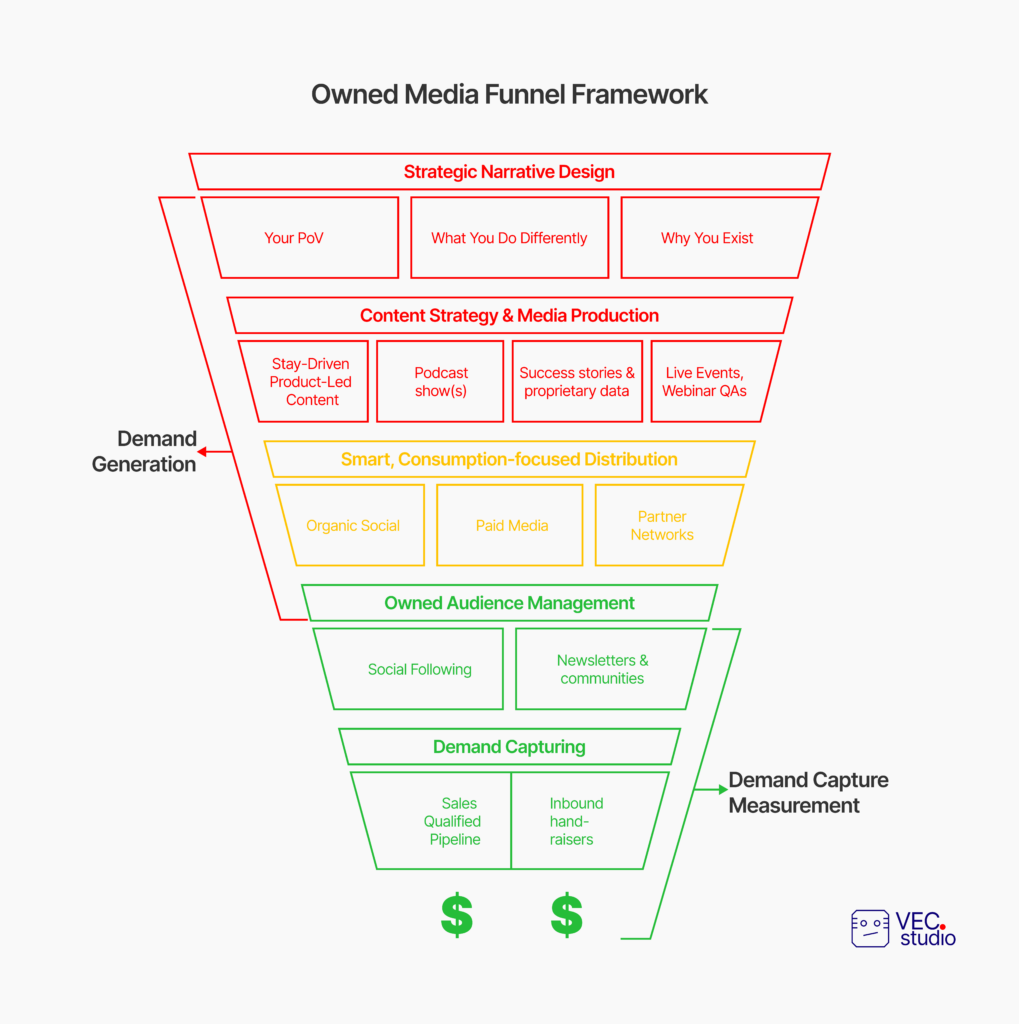
Two reasons to give this framework a look.
1. It Ticks All B2B Media Funnel Boxes
As noted earlier, going the media content route isn’t to appear cool or win badges for publishing Oscar-winning documentaries. You’re still marketing a B2B SaaS, and as such, all efforts must funnel into demand generation.
Steps 1-3 of the framework ensure that.
Take this inbound sales inquiry of ours:
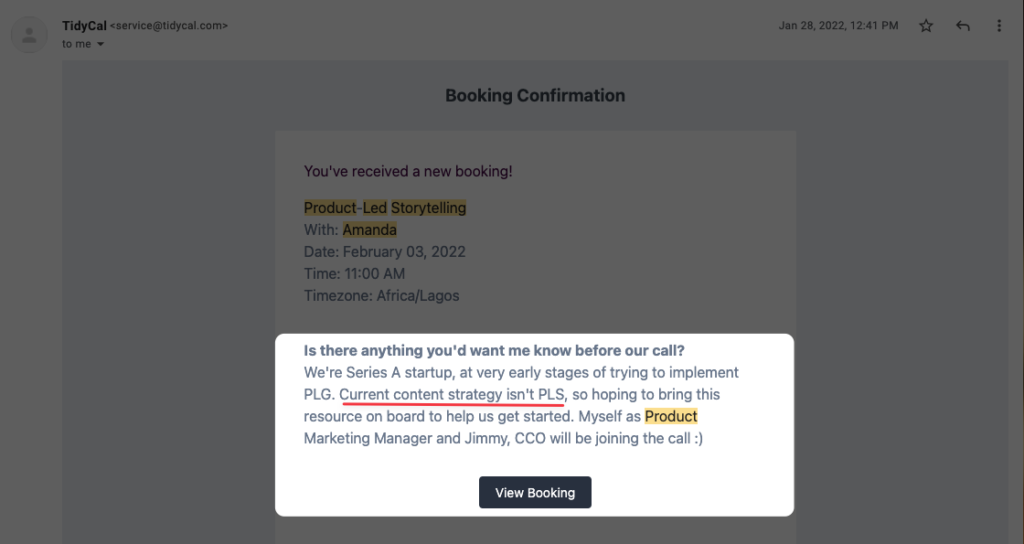
Positioning our studio around our Strategic Narrative, Product-Led Storytelling (PLS), crafting content to educate target ICPs on the same, and distributing for in-feed consumption, is how we got Amanda into our audience platform, our newsletter, and funnel.
You may be wondering, how do we know that?
Our HubSpot attribution data revealed it:
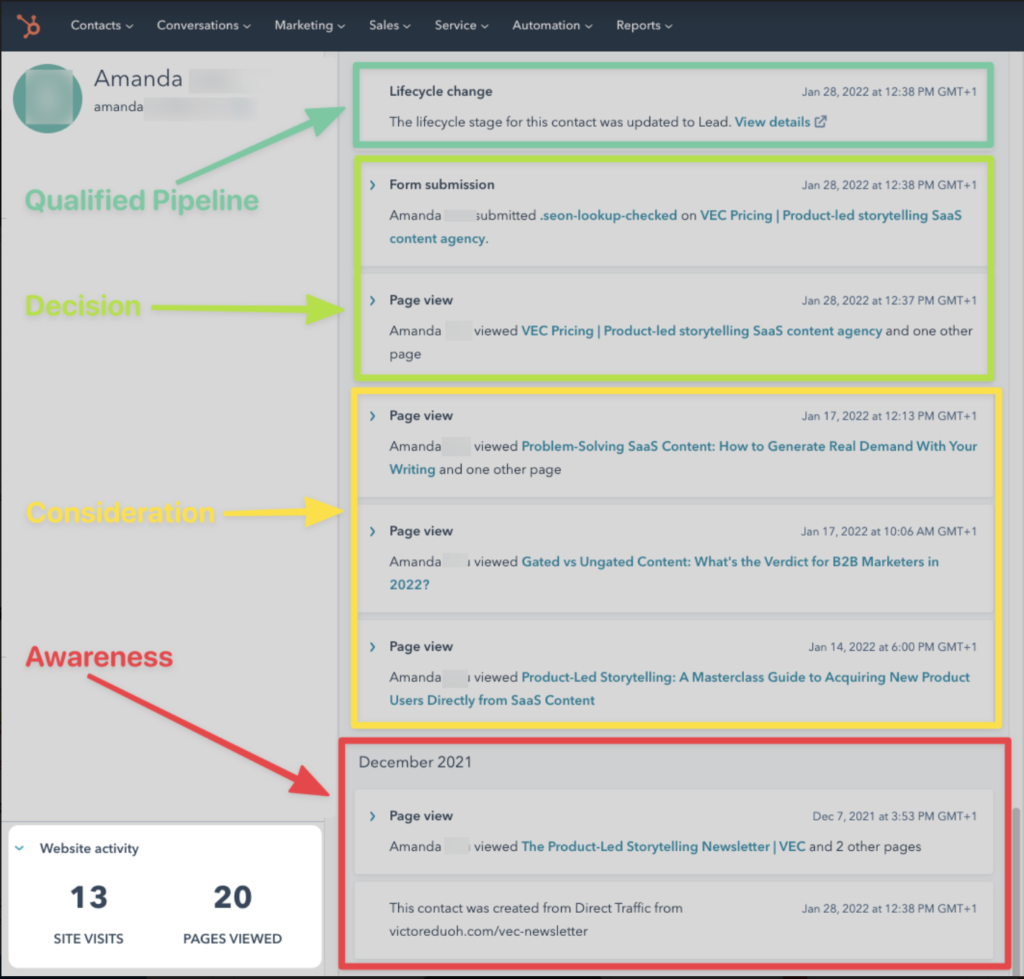
I’ll come back to this example.
2. It Reveals What Content Programs to Prioritize
In the quest to justify more marketing budgets, B2B Marketers often mistake one thing: Trying to capture demand directly. I get it. Sharing attribution reports with your CEO or CFO to show how many direct conversions your marketing generated is inviting.
But there’s a caveat.
When you obsess so much about capturing demand directly from marketing assets, you risk launching content programs that come off as too salesy. The result is sales-optimized marketing assets that alienate prospects, don’t get consumed, nor generate demand.
Prospects want to self-educate their way to a buying decision.
Marketing’s job isn’t to force them into a purchase. It is to make information available, earn mindshare, and align with the sales team to measure and do more of what’s working.
Linda Crawford once observed this:
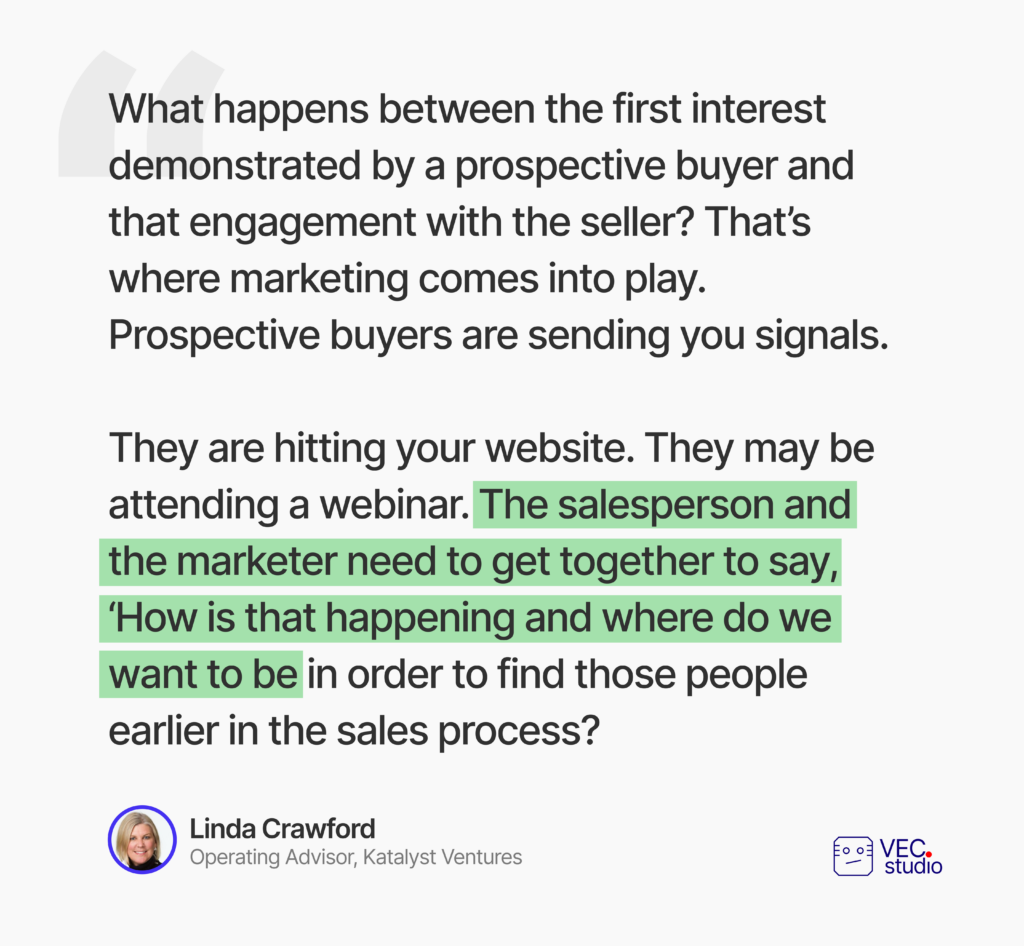
Measuring how you’re capturing demand, the 4 and 5th steps of the framework, reveal what media content programs are building your audience, easing buyers’ journeys, and moving the sales needle. You want to better the production of more of such content types.
Recall our Amanda example.
If obsessed over increasing conversions, we could’ve optimized the last content piece she read just before booking the sales call. In other words, focusing on capturing demand.
Measuring how we captured the demand instead revealed three interesting insights:
- She found us after someone shared our newsletter content
- She invited about 5 colleagues to subscribe to our newsletter
- She read over 9 content pieces shared through our newsletter and visited our site 20 times before booking the sales call.
Insights like this made us prioritize crafting and distributing more content prospects would actually consume and willingly share.
In short, measuring how we’re capturing demand (and not obsessing over capturing it directly) revealed the crucial role our newsletter plays. So we started treating it more like a media publication, made it more valuable, and renamed it “Growing with Content.”
While you’re still here:
The bottomline of all these is straightforward.
Whether you buy or are becoming a media company, the goal is to generate demand and funnel prospects into sales opps. But to be successful long-term, measure how you’re capturing demand in that funnel, as this insight will reveal what content programs to prioritize.
Here’s how to execute each step of the framework to achieve that.
Executing the Owned Media Funnel Framework
Execution starts with differentiation.
Specifically...
1. Strategic Narrative Design

If competitors in your niche also become media companies, which is very likely, how will you differentiate your brand?
The answer to that question is why designing a narrative is the foremost step in the process. I’ll use real examples to demonstrate. From them, we’ll scrape insights into how you can also design and align on a Strategic Narrative.
Starting with Grammarly, an AI writing assistant.
From YouTube videos to webinars, text-based content pieces, and amazing newsletters, the company’s marketing team produces a shit ton of content to educate the market on several grammar blunders that its AI tool can solve.
But the overall effect of their broad and amazing marketing strategy execution doesn’t position them as an AI tool.
Instead, Grammarly’s narrative is:
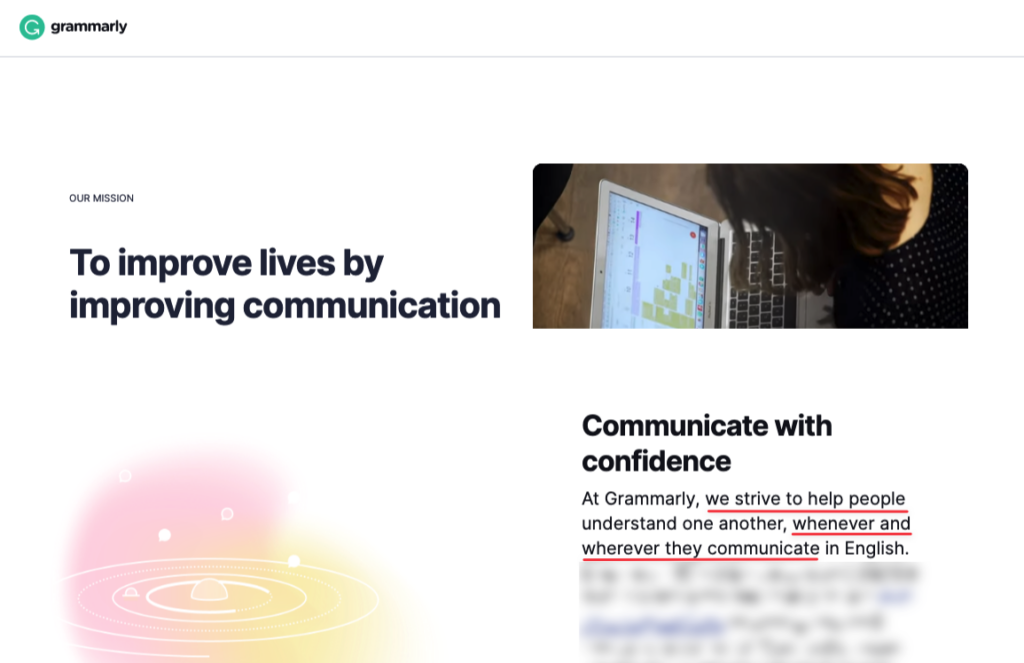
To uncover this narrative, the company’s Founding team asked serious underlying questions seeking to understand the transformation initial users truly desired.
According to Max Lytvyn:
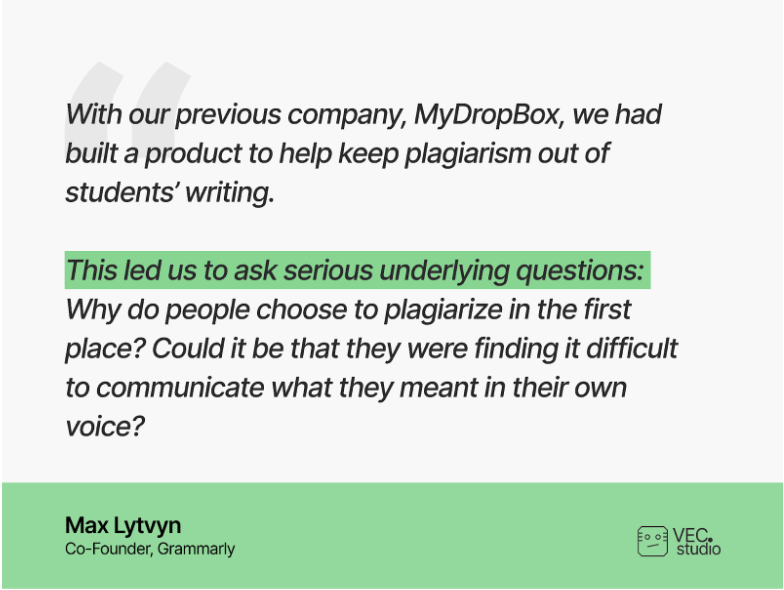
A myriad of people uses Grammarly.
In fact, anyone who writes in English needs an AI grammar checker. This is why their marketing doesn’t project a narrative that leans toward a specific demographic. Instead, it rallies the desired transformation sought by users across the board: “Improve [their] lives by improving [their] communication.”
Using Grammarly as a model, the lesson (and action plan) if you are marketing a product used by various people are:
- Look beyond your features and core product capabilities.
- Ask serious underlying questions to identify the common transformation desired by all your customer demographics.
- Use this insight to design a Strategic Narrative your overall media-focused marketing strategy execution will project.
Let’s see a different example.
From the dozens of email software that existed, professional writers could pair one with a blog and set up a paid newsletter in a few clicks. GetRespoinse, MailChimp, Infusionsoft, Sendinblue, Aweber, ActiveCampaign, MailerLite, you name them.
Yet, most professional writers didn’t think of using these tools to become independent, write, and monetize subscribers directly.
Until Substack came on the scene:

In Bailey Richardson’s words:
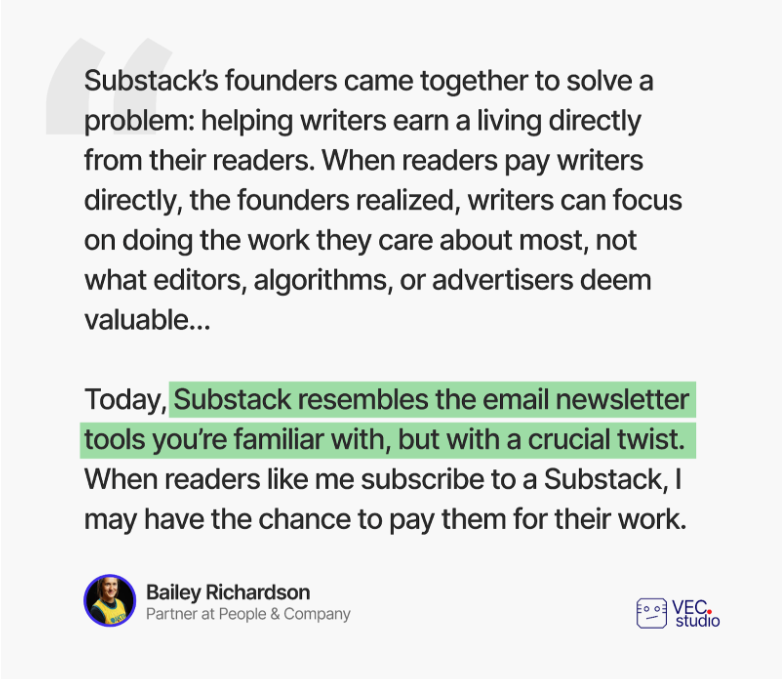
Today, Substack’s entire media-focused marketing efforts through its own newsletters and podcasts revolve around this narrative.
It is so appealing (credits to them for executing it to the fullest) that established authors who leave end up returning to focus on writing while Substack helps them handle the rest.
One good example: The Generalist:
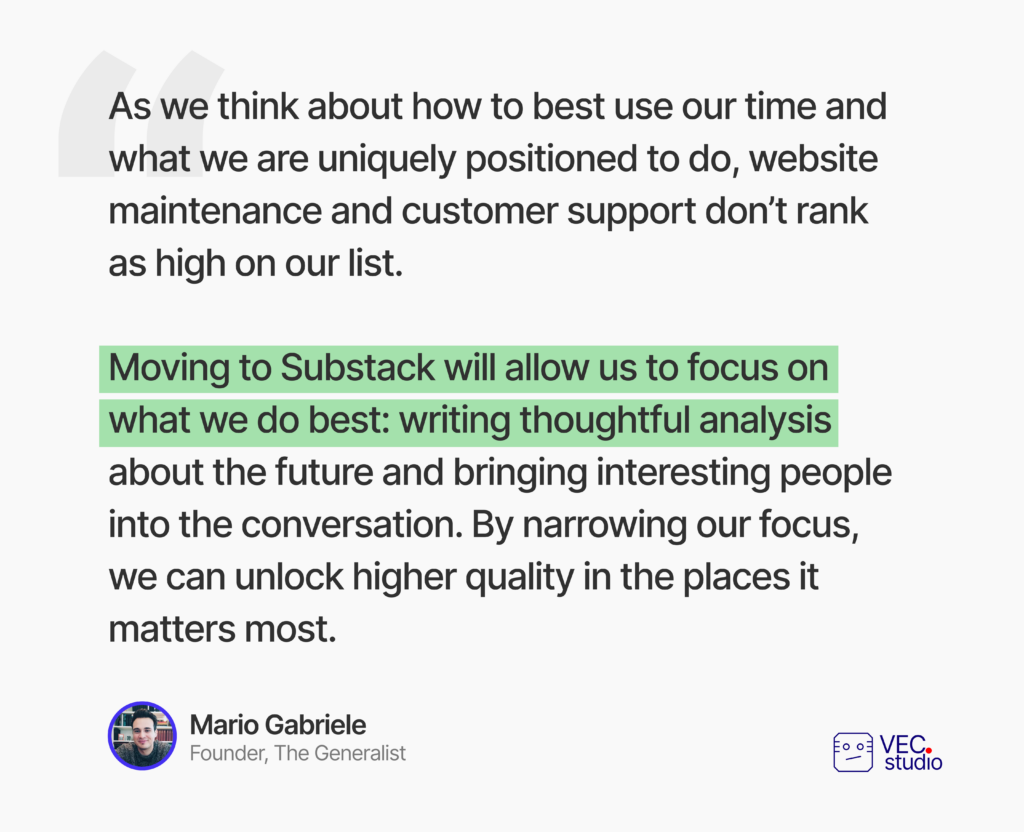
So, if you’re marketing a product with a niche use case, here’s the lesson (and action plan) you can learn from Substack’s example:
- Identify a problem the underserved market segment didn’t think of or know they could solve with existing products.
- Understand the desirable value you can unlock for them if they solve that problem with your product.
- Use this insight to design a Strategic Narrative your media-demand gen marketing strategy execution will project.
The success of Grammarly, Substack, and others we’ll explore as we proceed proves that aligning on a Strategic Narrative is a non-negotiable foundation for taking the media-demand route.
Here’s why.
Most competing products have the same capabilities as yours. In short, competitors can copy your features in no time. So before becoming a media company, it makes sense to design a narrative that differentiates your company.
You don’t want to be lost in this maze:
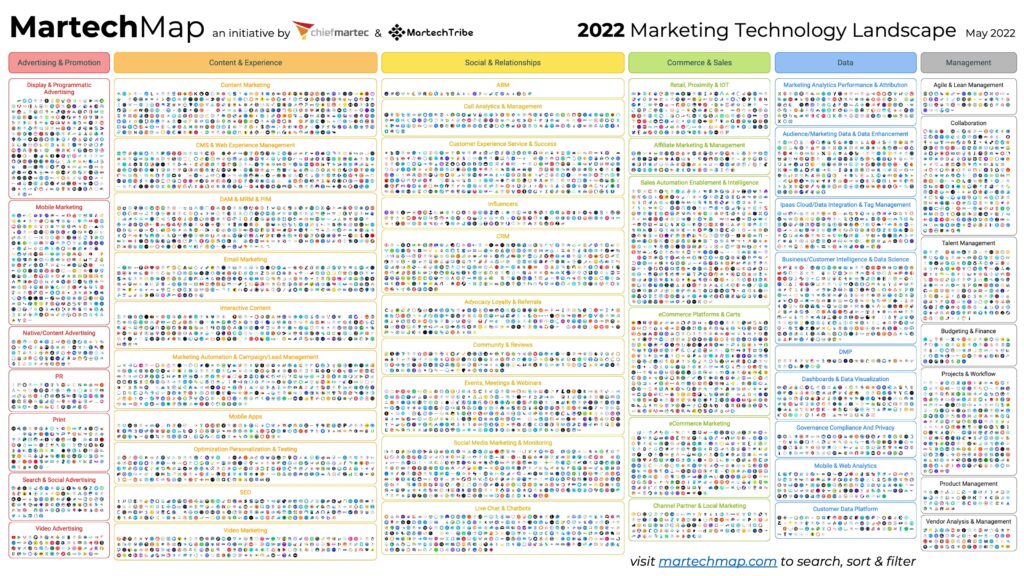
Taking cues from Grammarly and Substack, designing one comes down to a lot of activities we like to break down into three segments.
- Honest company evaluation.
- Target buyers' research.
- Direct and indirect competitor research:

Getting this right is so crucial.
In short, the success of most, if not all, media-focused B2B SaaS content marketing execution depends on it. That’s why we prioritize it in our work approach:
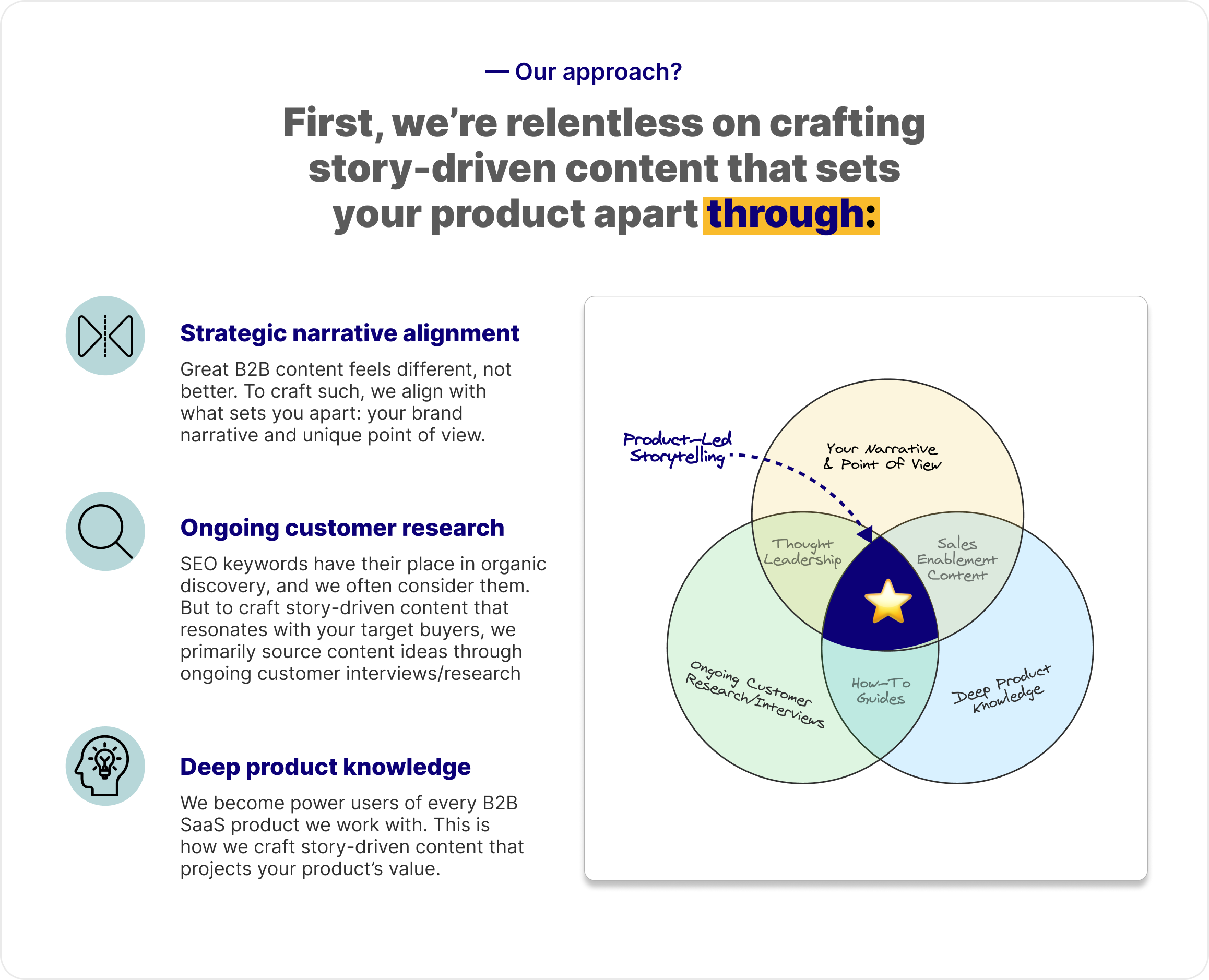
2. Content Strategy & Media Production
Narratives don’t develop wings of their own.
No one’s out there waiting for you to align your product on a narrative for them to unlock their wallets. If your marketing doesn’t create awareness for both, no one will care, and you won’t generate demand.
Victoria Gamlen said it best:

Gamlen’s advice is one of those easy-sounding B2B marketing ones: Nail your content, and you’ll nail demand generation.
But how exactly do you do that?
It starts with developing a content strategy. And developing one, especially when you’re taking the media-demand gen route, begins with providing concrete answers to questions like:
- What pain points and jobs to be done will you educate target ICPs on how to address and solve, respectively?
- In educating them, how will you present your arguments relative to your narrative and how your product solves those problems?
- Who (i.e., Subject Matter Experts, SMEs) will create content the target market(s) and ICPs will trust?
These three questions should be clarified before anything else. The reason is simple. You need expert-level, narrative-driven content crafted specifically for well-defined ICPs.
Creating ICP StoryScripts (a fusion of buyer personas and JTBD) is one way we help B2B SaaS companies nail the questions above:
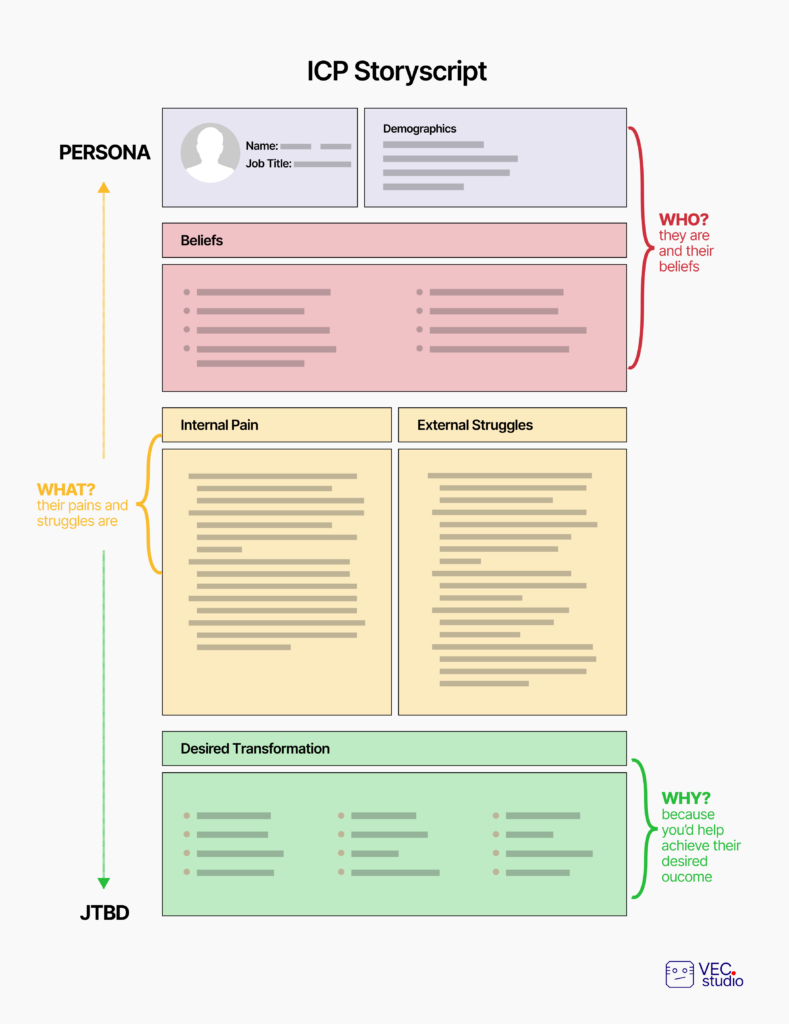
That’s the ‘Content Strategy’ part.
The ‘Media Production’ part deals with two questions:
- What topics are you going to talk about? And
- What content media types are you going to produce?
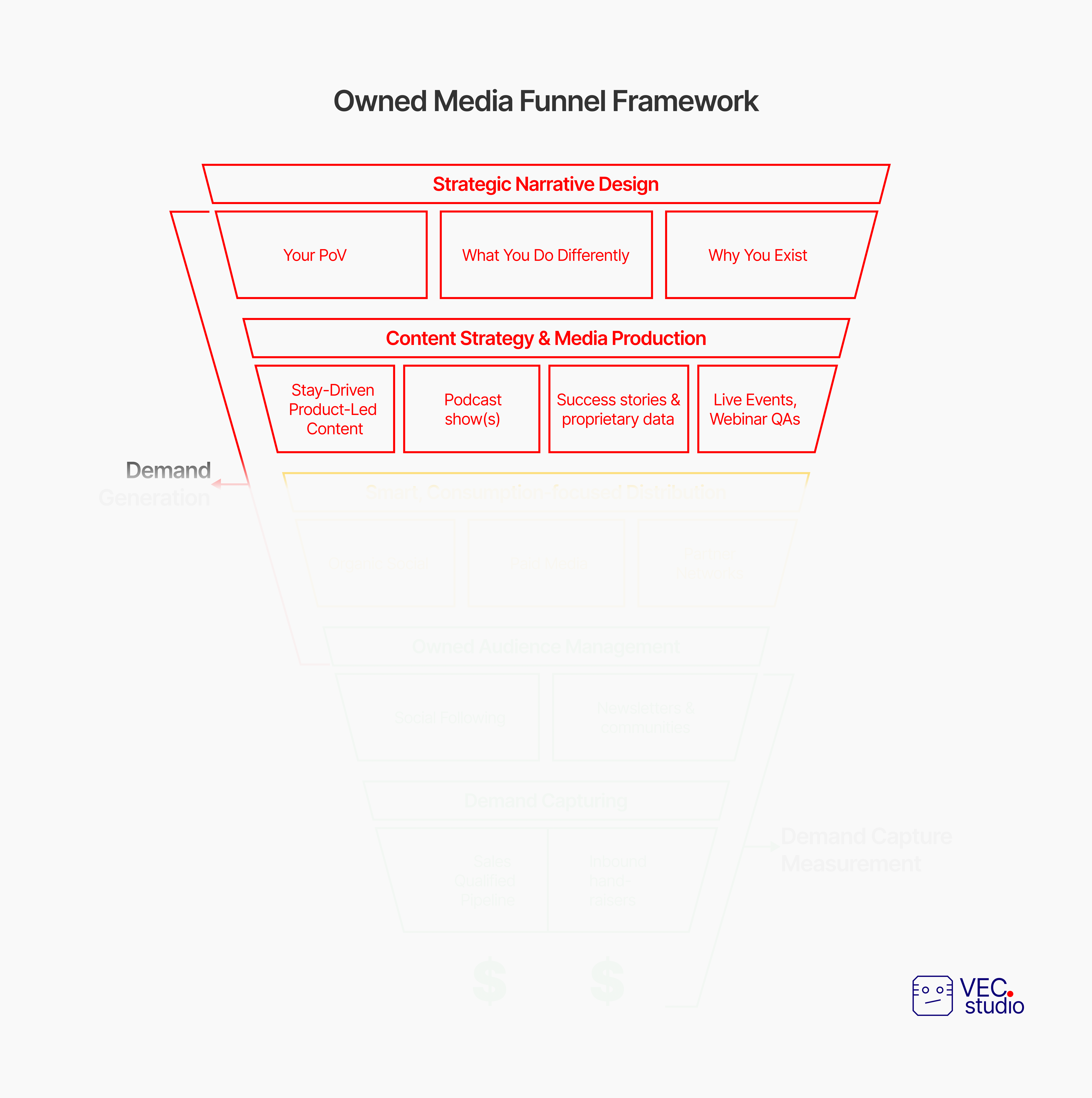
As shown in the illustration, you can produce:
- Story-driven,
- Audio or video podcast shows,
- Success stories & proprietary data insights,
- Events, webinars, QA sessions, etc.
But whatever content type(s) you choose, you’ll need multiple of them to address queries related to your chosen topics. Also ensure that ongoing content creation builds on each other by clustering content around topics to achieve topical authority.
VEC’s Topic Cluster Content Strategy (TCCS) Framework helps us develop such content marketing strategies for clients:
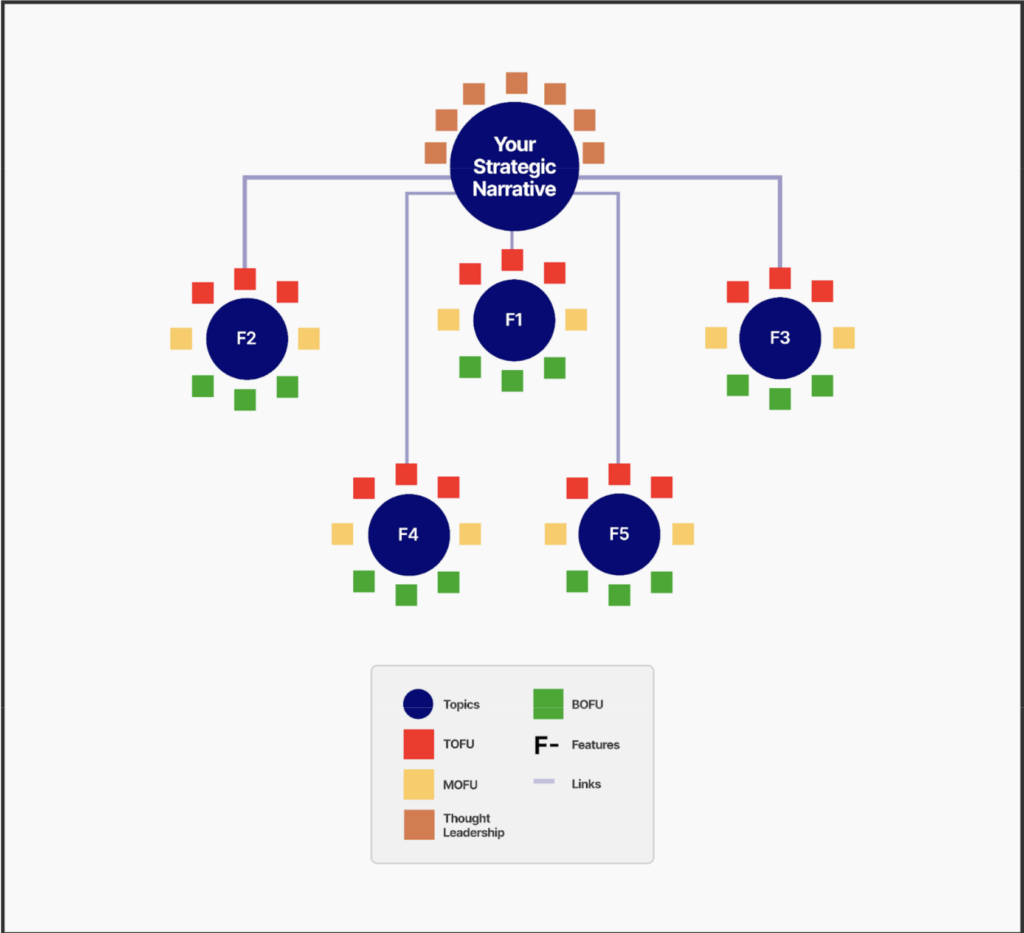
A final thing worth considering is the prioritization of keywords and content ideas. On the one hand, you want to create thought leadership content to project your overarching narrative. Then, for each topic cluster, prioritize keywords, ideas, or queries where your product is an irreplaceable solution to the problem(s) those content will address.
One way to do this is by using a score of 0-3 to prioritize what keywords, ideas, or queries go into your content plans:
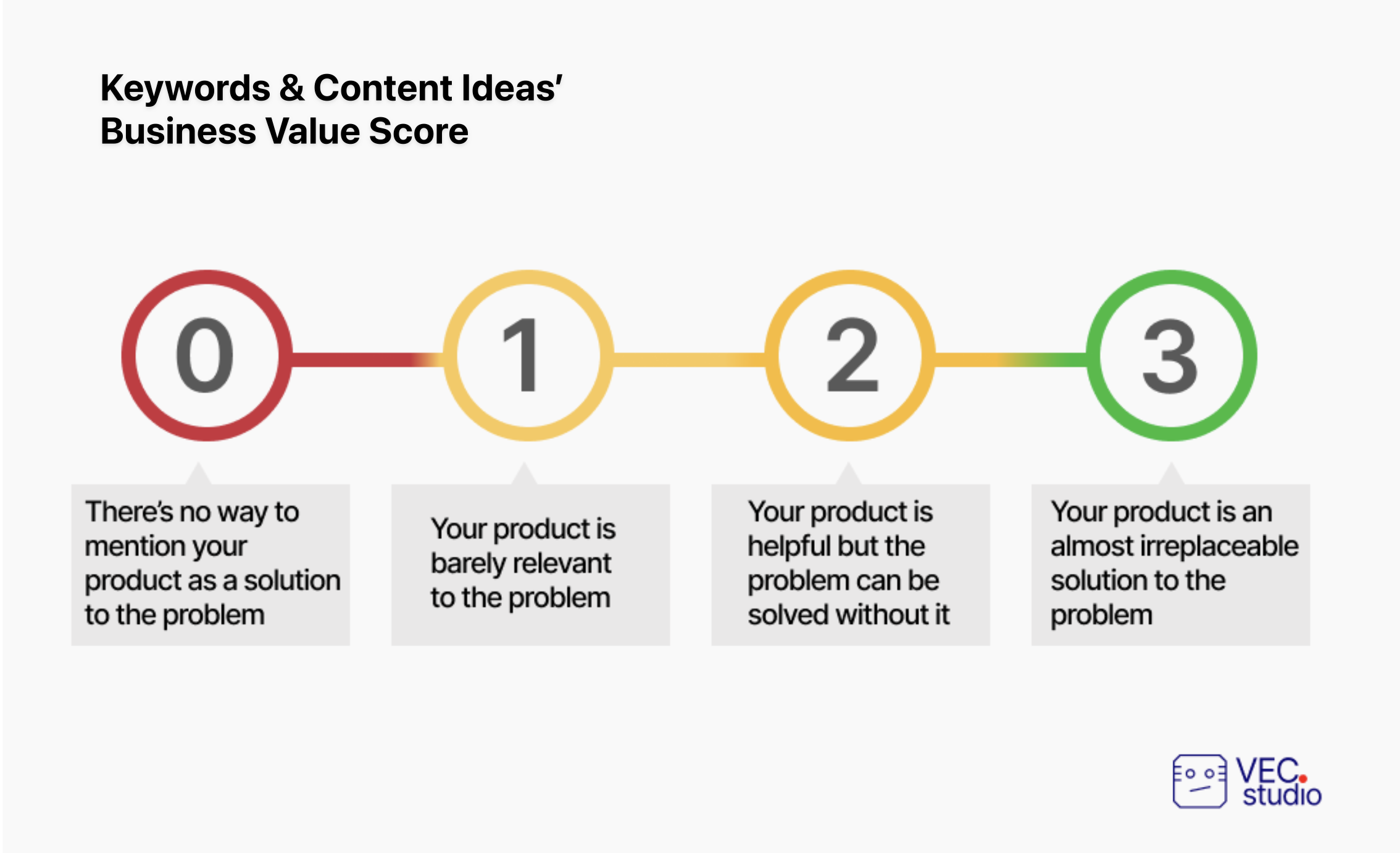
3. Smart, Consumption-Focused Distribution
I’ll let B2B experts who have skin in the media-demand gen game lead the recommendations on distribution.
In one of her podcast episodes, Camille Trent said:

I agree 100% with Camille.
Create exceptional content first and foremost. By this, I’m referring to content your ICPs yearn for and can’t get enough of due to its value and the rare insights it shares.
Chris Walker, the demand gen mogul on the same podcast episode hosted by Camille, shared the next step after creating great content.
In his words:

I also agree 100% with Chris.
Content, no matter how valuable, is useless if the target market(s) and ICPs you want to educate don’t find them. Chris used podcasts on Apple or Shopify Stores as an example. But the content type or format it is produced in is secondary here.
The crucial point is to distribute excerpts of your content for in-feed consumption on channels where target ICPs hang out. Your team can do this through organic social, paid media, or partner networks:
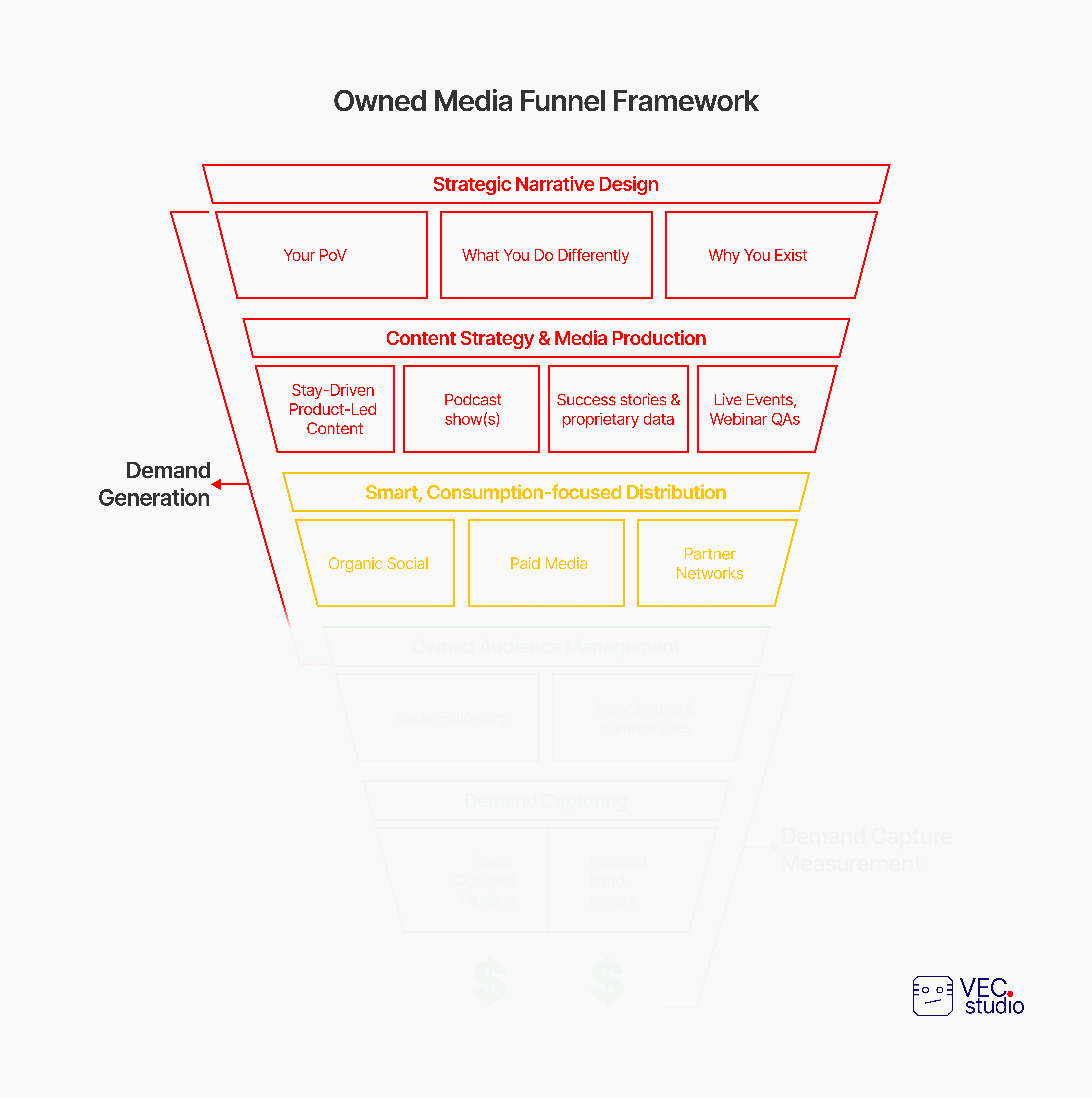
It’s even better to have distribution baked into your team’s content creation process. This will keep creating content with valuable excerpts for distributing on channels your ICPs hang out at the back of their minds, making what they produce a lot easier to distribute.
The VEC process embodies this:

And that brings us to step 4.
4. Owned Audience Management
By-products of distribution on channels ICPs hang out are:
- Social followers who increase the chances of more people seeing your content on their feeds whenever they engage,
- New community members or newsletter subscribers:
Don’t forget why you’re becoming a media company: To educate a target market, create awareness, generate demand for your B2B SaaS, and funnel that demand into pipeline in the long run.
But prospects’ path from awareness to closed-won isn’t linear. The Gartner research cited earlier showed that tech buyers spend about 83% of their time self-educating in various ways. Another study reported by MARTECH found that on their journeys to buying software, B2B buyers consume 13 pieces of content on average.
Put both data points together, and you get this:
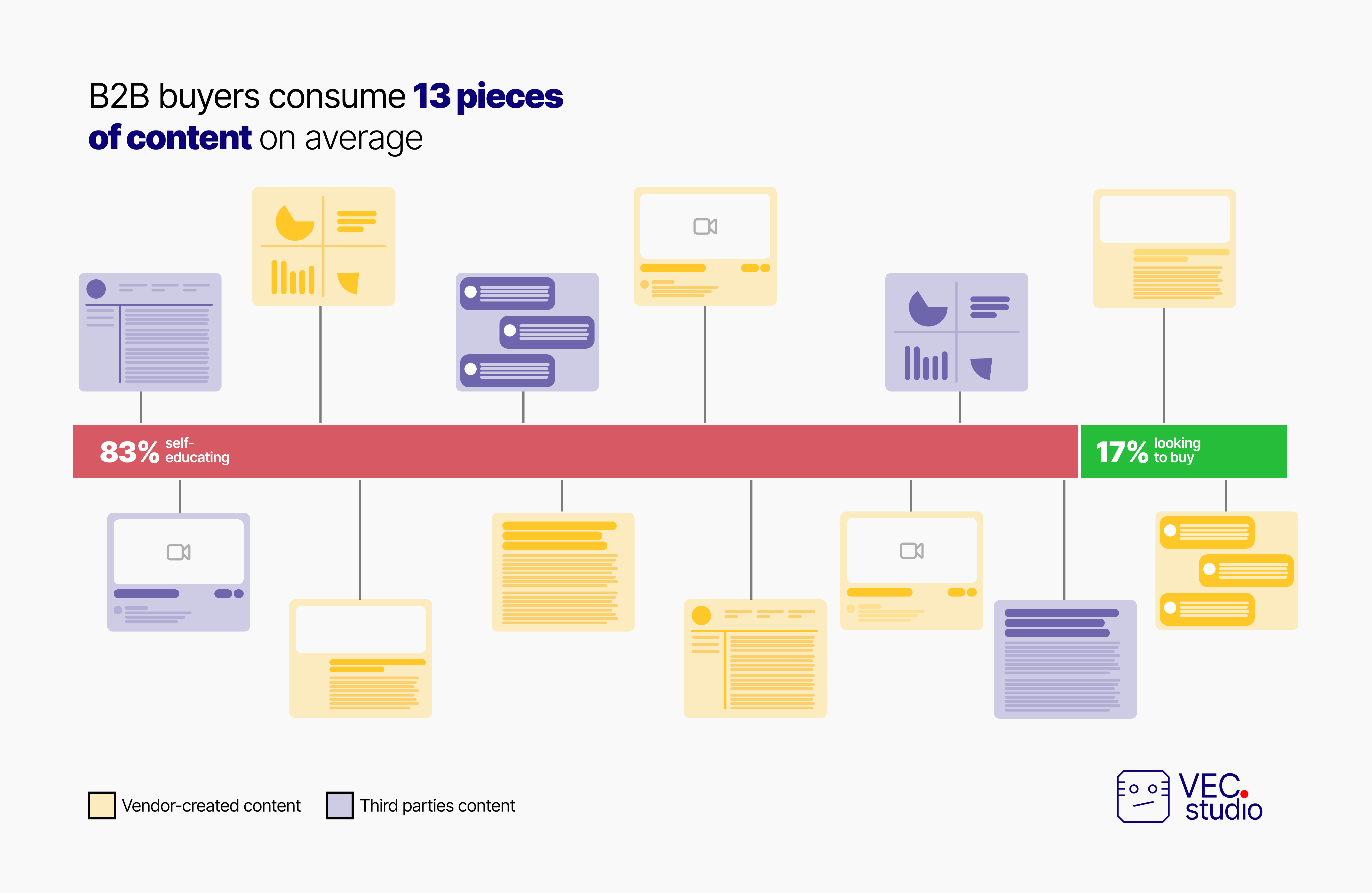
The challenge:
If prospective buyers need to consume at least 13 of your content pieces during 83% of their self-educating period before you can funnel them into sales opps, how do you increase the chances of delivering enough of the right content to them?
By owning and managing them in your audience:
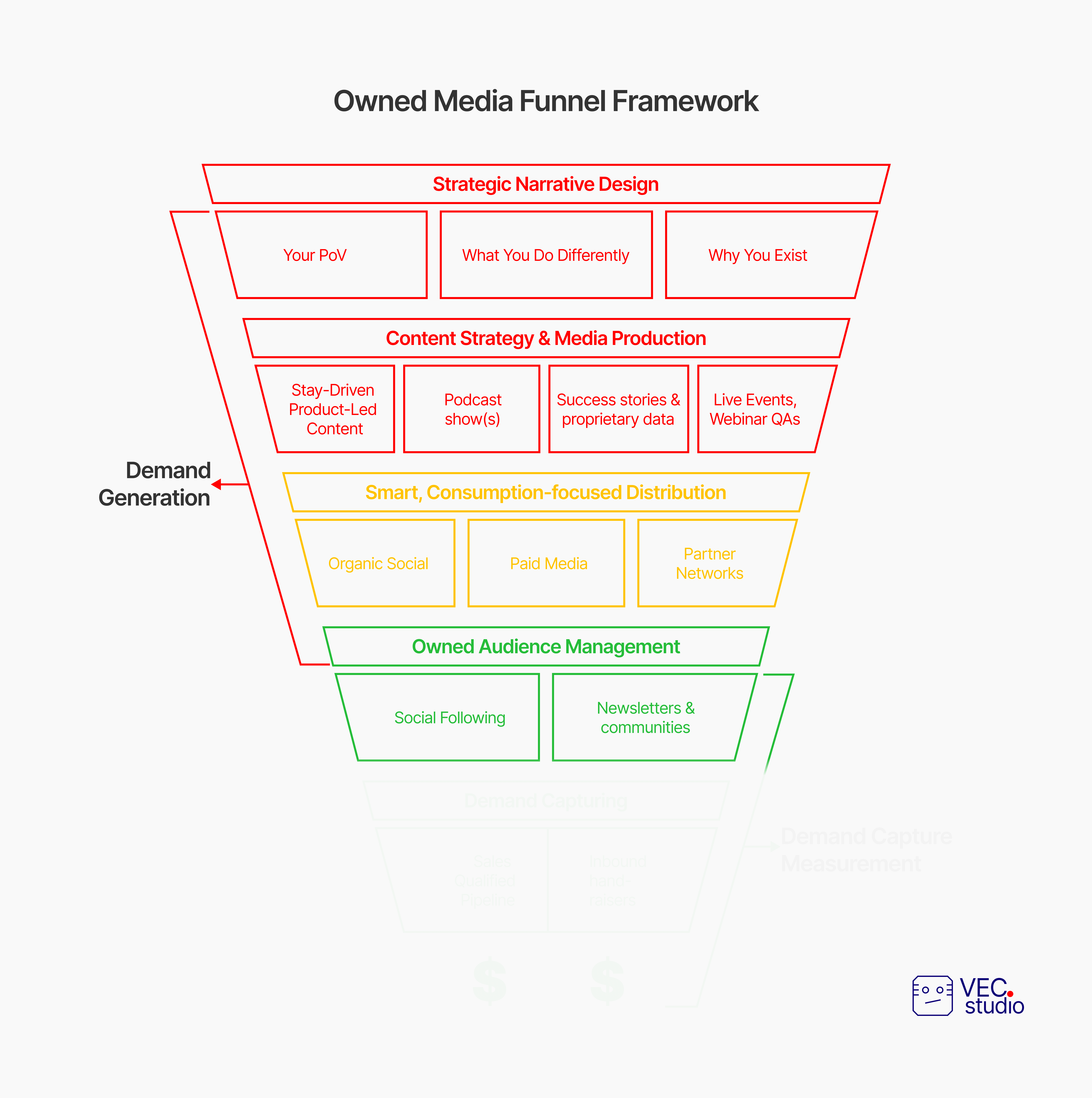
Owning and managing your audience on platforms you own, and not relying completely on rented grounds like social media, gives you control over how and when you distribute content.
This is crucial, as observed by JK Sparks:
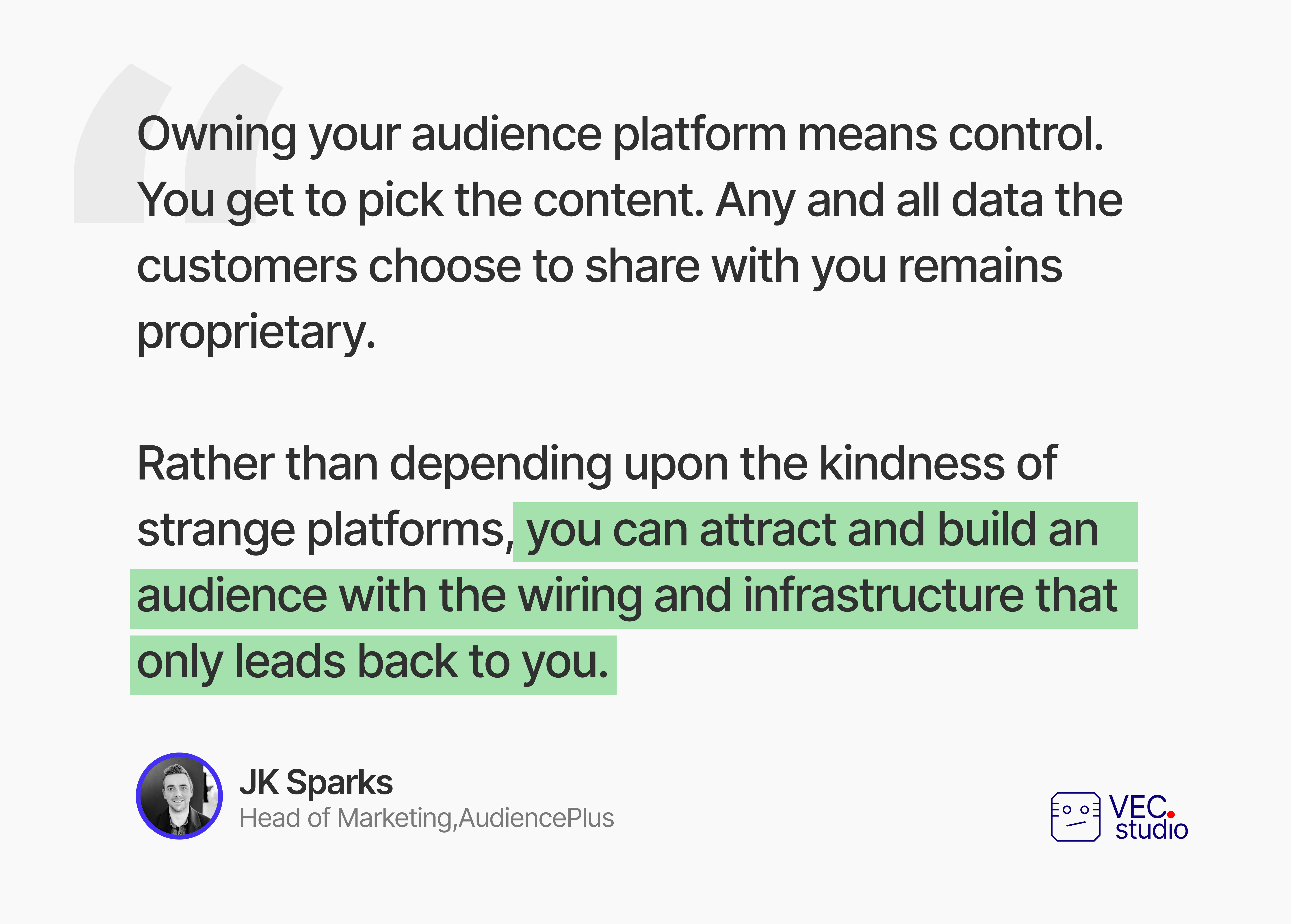
The benefits of owning and managing your audience don’t end with being in control of how and when you deliver the right content. You also get the benefit of a directly-monetizable community.
Take the case of PeerSignal and Keyplay:
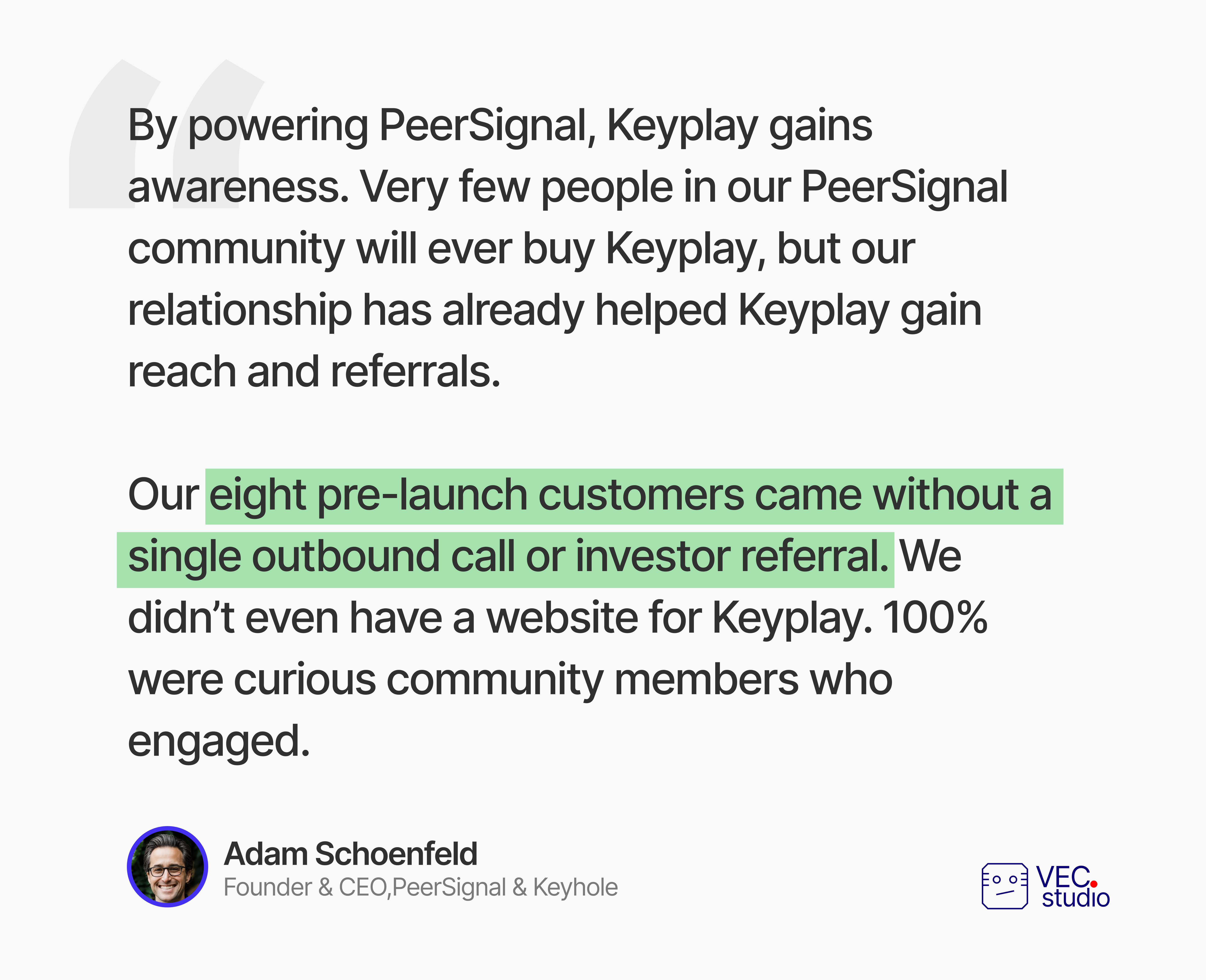
Due to these benefits, as part of VEC’s content crafting process, we create excerpts to help our clients deliver enough native value and transform their newsletters into audience-building assets.
Here’s one example:
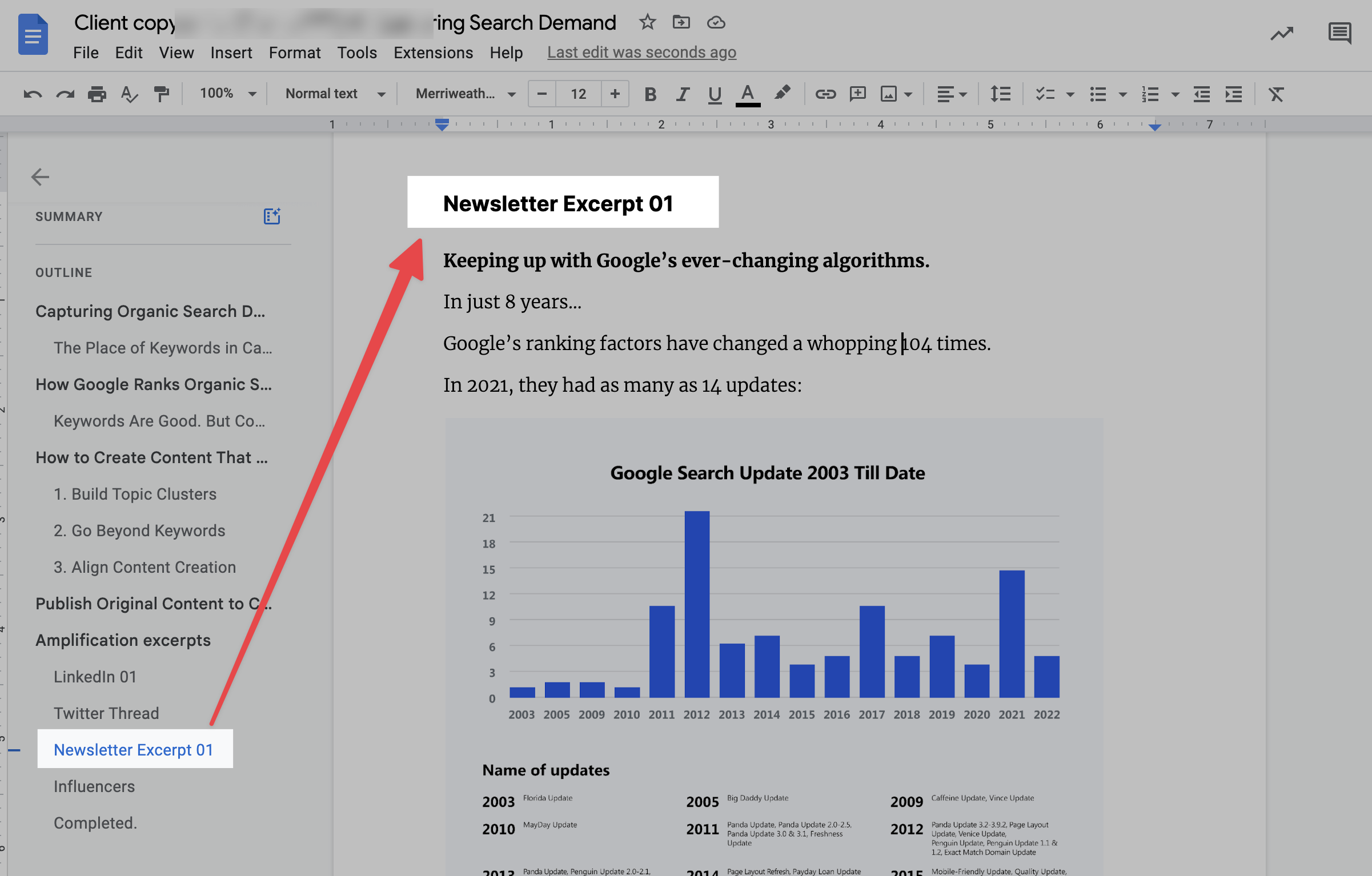
And the result of doing this speaks for itself.
Take VEC’s newsletter, “The Studio.” People find these well-crafted excerpts so valuable they share them with others in their network.
Don’t take my word for it:
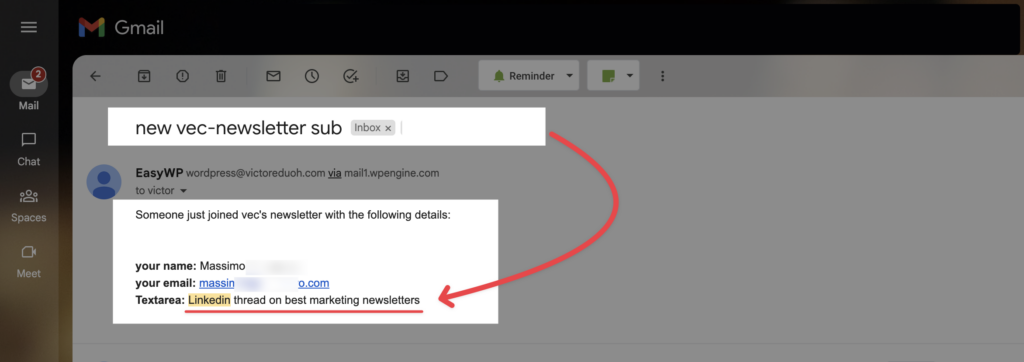
5. Demand Capturing
All four steps so far were to arrive at this 5th one:
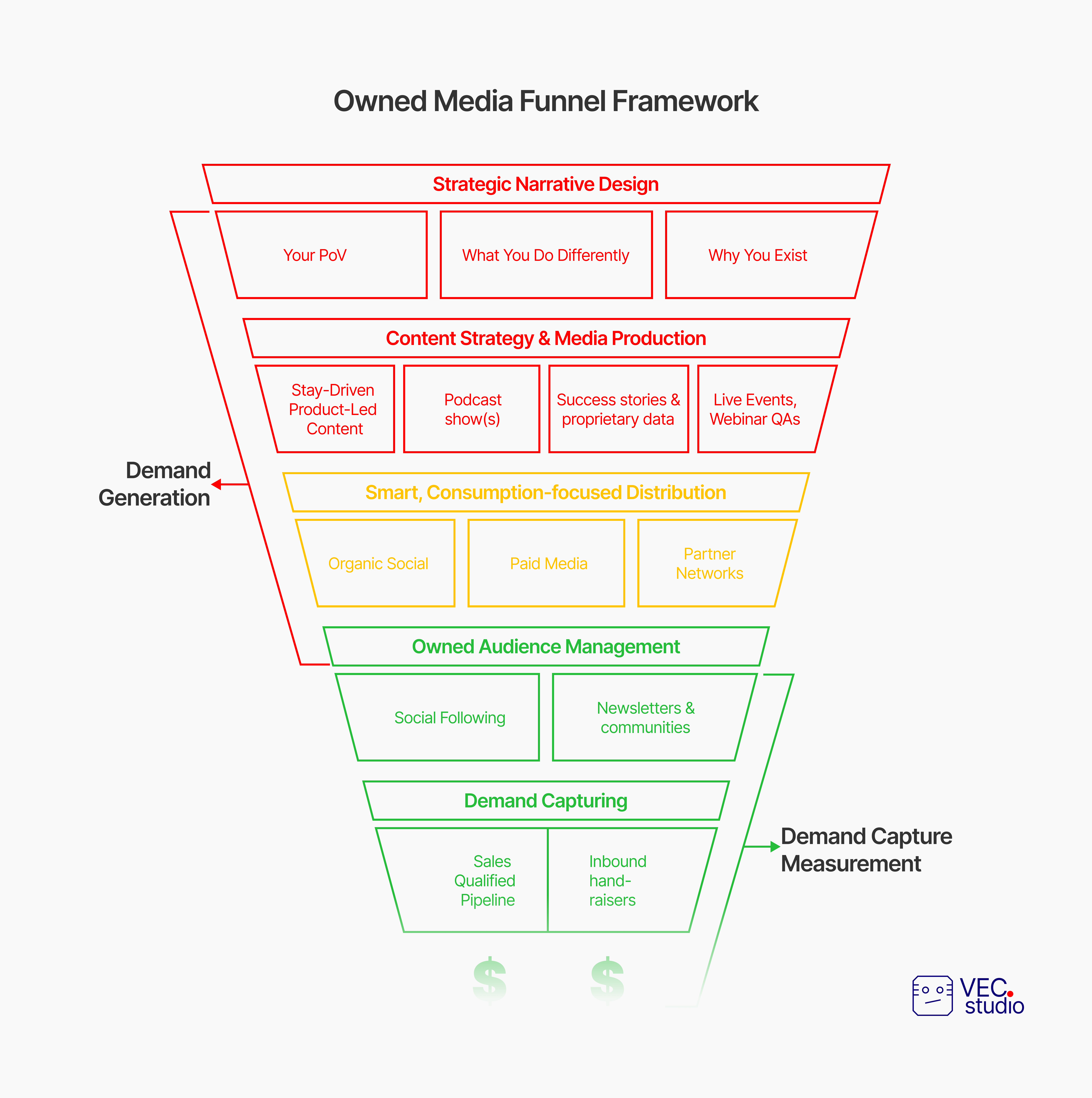
But this step of executing the Owned Media Funnel Framework, if misunderstood, can make your marketing team focus on the wrong things. Hannah Swanson shared the same view and a recommendation I agree 100% with.
She wrote:
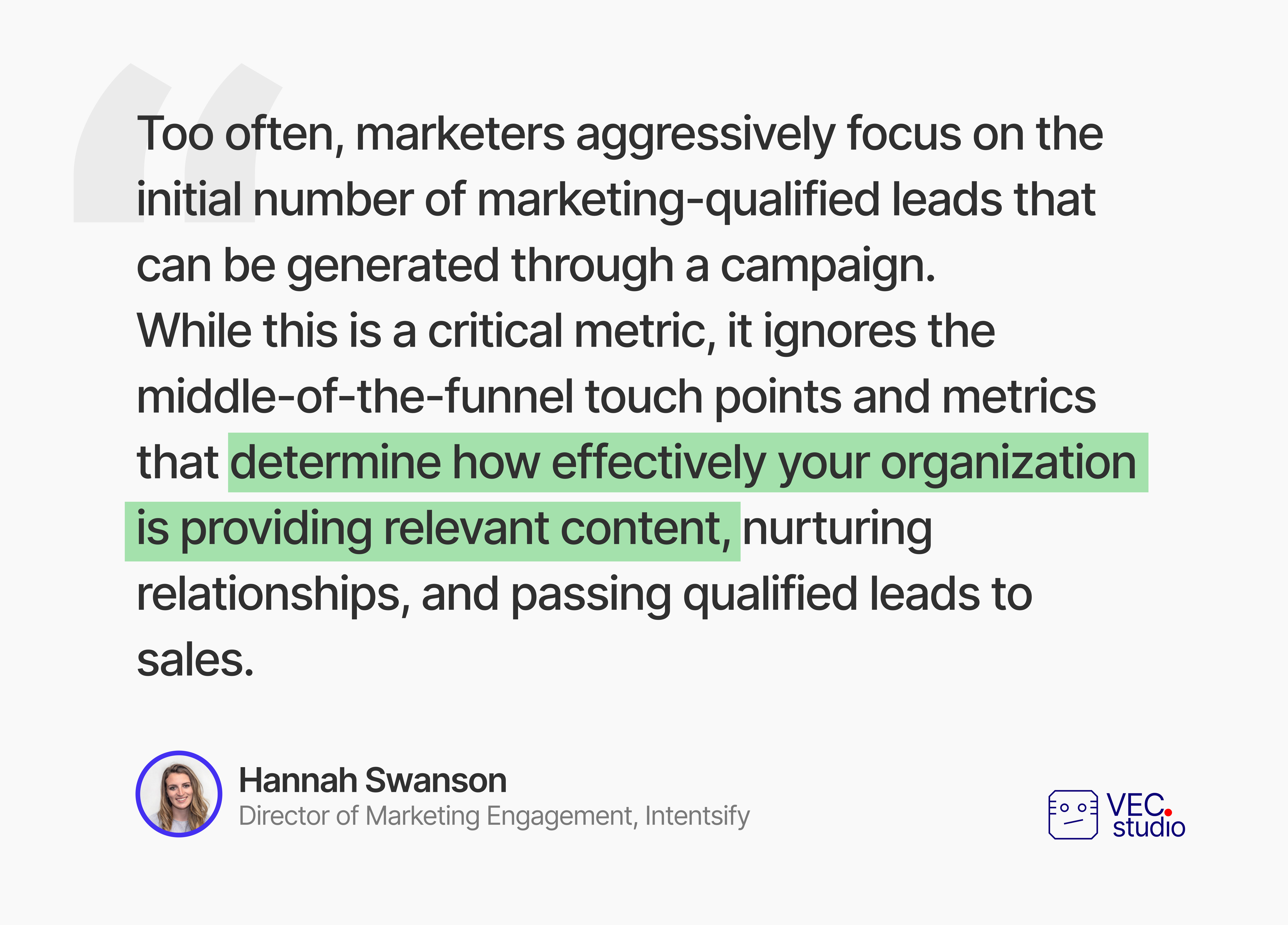
Here’s how I’ll execute this step.
Just before I begin to manage my owned audience, I’ll have the right tech stack in place to measure how my media-demand content efforts are influencing the sales pipeline.
The crucial automations I’ll put in place are:
- In-product conditions or media consumption signals for qualifying right-fit prospects and passing them on to sales,
- Tracking of what’s nudging inbound hand-raisers.
This setup can automate tracking metrics like MQLs, SQLs, PQLs, CPC, etc. So instead of obsessing over them, as Hannah suggests, your marketing team can focus more on determining your content programs’ effectiveness.
Specifically, try to discern what content types prospects consume the most and the ones driving them down the funnel. With this insight, your marketing can produce more relevant content, create more awareness, and generate even more capturable demand.
We call it becoming a media company for this reason.
Start With What You Have
Don’t complicate becoming a media company.
You mustn’t buy the next The Hustle or Sales Hacker, as HubSpot or Outreach did, respectively. You don’t even need a fancy studio as Refine Labs, or AudiencePlus does.
In my view, the core elements are:
- Have a unique narrative,
- Build a content marketing strategy,
- Decide on a content type you can produce today,
- Craft great content prospects actually yearn for,
- Distribute excerpts of the content where target ICPs hang out.
- Measure how you’re capturing demand.
CBInsights, for instance, don’t produce documentary-style shows as Profitwell’s Recur Media does. Well-researched content pieces referenced by top business analysts across sectors are how they built an owned audience of over 800k newsletter subscribers.
PeerSignal is in that boat.
Their main driver to over 14k owned audience in less than 18 months came from producing written content with GTM data insights. Adam Schoenfeld distributed excerpts of this content on his LinkedIn, luring people to sign up for more by joining their newsletter community.
In Adam’s words:
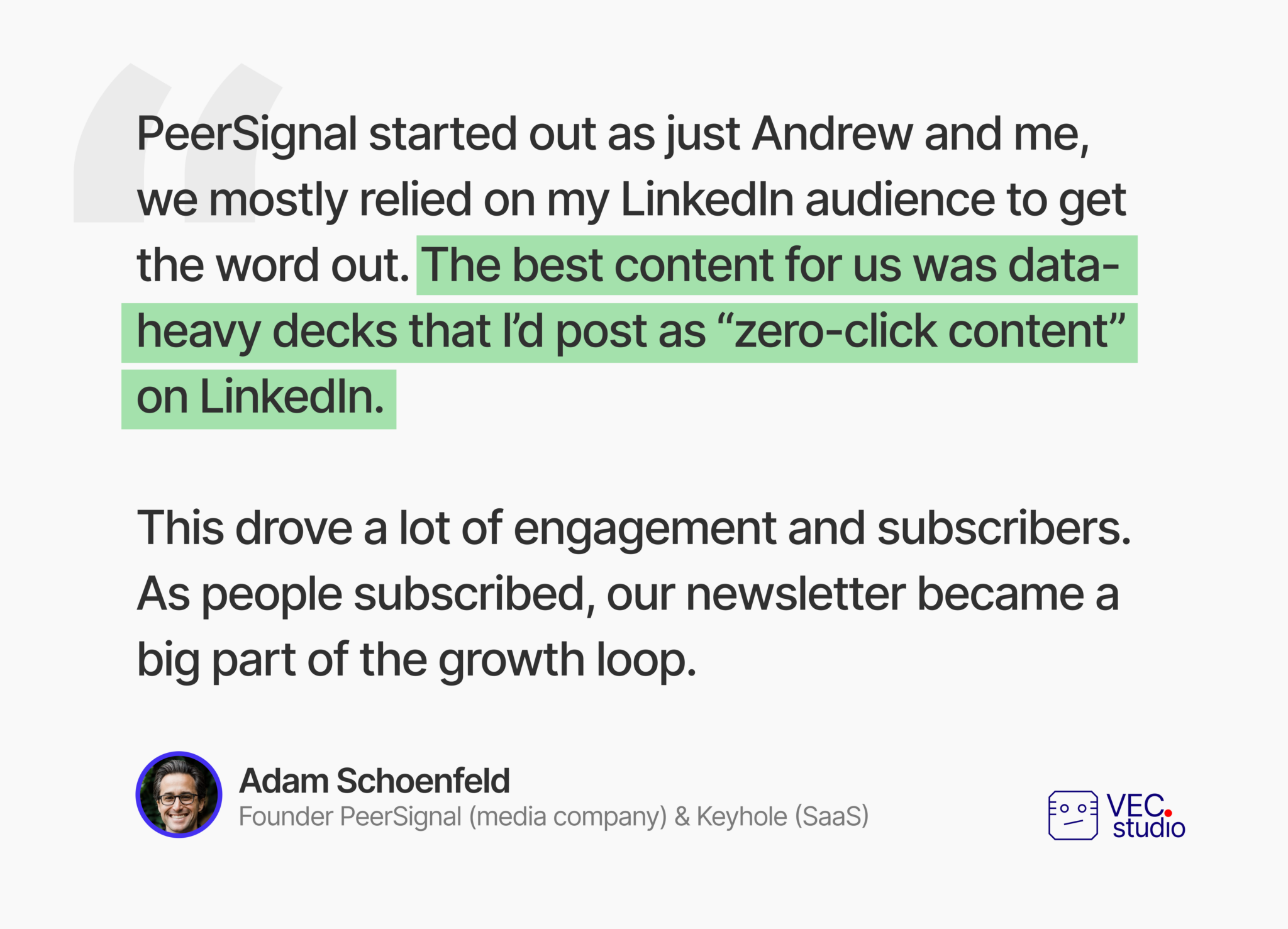
No podcasts, no fancy studios, and no shows.
The one thing these companies do well is their ability to subtly weave their products into the articles they produce. They do this by sharing proprietary product data or showing (not just telling) how their product solves the problem each of their content pieces is addressing.
Doing this and doing it well is a superpower.
And it is one of many reasons clients trust VEC:
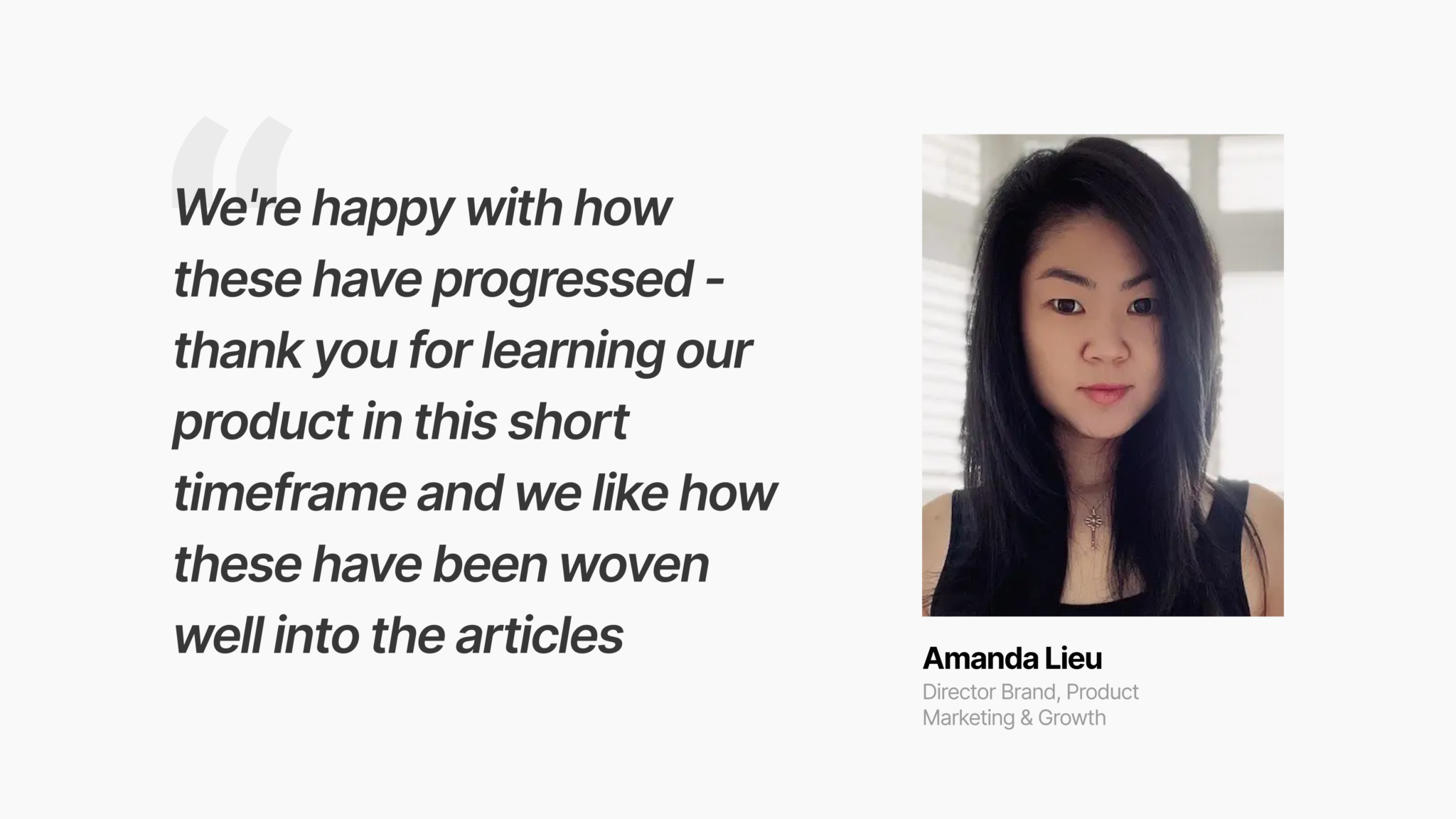

Victor Eduoh
Lead Strategist @ VEC
Founder, Lead Strategist @VEC. Thinker, reader, words-crafter, and husband to Omosede. Besides crafting product-led stories, I love scouting and grooming rare marketing talents.
Rare insights, in your inbox
How do SaaS Founders and B2B Content Leaders build brand and drive growth through story-driven content execution? Dig that, plus rare Product-Led Storytelling insights, in this bi-weekly newsletter.
Get a copy of our Story-driven, Content Quality Checklist –FOR FREE– once you subscribe.

